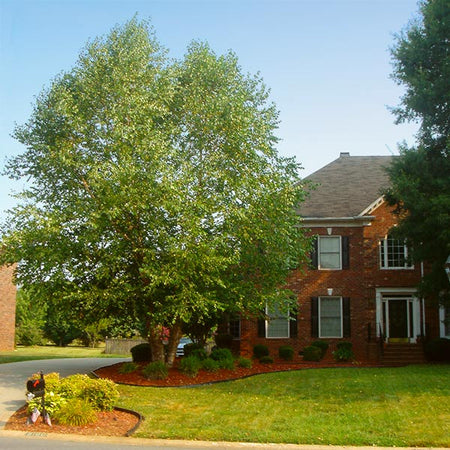Birch Trees
Showing 1 - 3 of 3 items
Starting at $128.99
Growing Zones: 4-9
Sold Out
Growing Zones: 2-6
Starting at $66.99
Growing Zones: 4-9
Easy, Attractive Shade Trees
Birch trees are known for their delicate leaves and neat growing formations. These deciduous trees are often called a "pioneer species," due to their ability to thrive in a variety of climates and conditions.

A medium-sized tree, most birch trees grow 30-50 feet tall with shallow rooting systems, making them a popular addition in small yards and urban areas. They also love moist environments, making them perfect for accent trees near lakes or ponds.
Birch trees typically have attractive bark, with shades of white, grey, and even silver. Their foliage is small and delicate - bright green hues in spring and summer turn yellow in fall, and their drooping canopies can provide a shady spot in your home garden.
Types of Birch Trees
Belonging to the genus Betula, birch trees are common in the Northern Hemisphere. They can grow as trees or shrubs, and most share the same distinctive, papery bark.
Here are a few of our favorite birch tree varieties:
Heritage River Birch Tree: With a maximum height of 70 feet and a canopy of shade up to 60 feet wide, this birch tree grows quickly, making it a great addition for those that want a feature tree without waiting decades for growth.
Dura Heat River Birch Tree: The River Birch Tree features unique, flaky bark in shades of white and brown, which complements its small green leaves. It’s also cold- and heat-tolerant, as well as fast growing.
White Birch Tree: This tree grows with the most stunning, eye-catching bark you'll find! The smooth, sandy-white bark is made even more striking when the trees leaves turn golden-yellow in the fall.
Benefits of Birch Trees

Why plant birch trees in your landscape? We've got a few reasons:
- Fast-growing: Birch trees, like other pioneer species, can grow quickly in a variety of conditions. Birch trees grow well in growing zones 4-9.
- Attractive bark: Offering varying shades of silver, white and brown and displaying a unique peeling texture, birch are loved for their visually appealing bark.
- Shallow root systems: Shallow roots allow birch trees to be planted in just about any environment - including urban landscapes.
- Loved by butterflies: If you want to attract butterflies to your yard, then a birch tree is a great choice. Many species of birch are chosen by spawning butterflies to lay their eggs on.
A few things to keep in mind about birch trees: they can be relatively short-lived compared to other hardwood trees, and they are susceptible to some pests and disease.
How to Plant and Care for Birch Trees
While birch are hardy and fairly low-maintenance, ensuring great growing conditions will see your tree thrive.
- Plant in cool, moist soil with good sun exposure to allow the trees shallow rooting system to take firm hold.
- Inspect the tree every few months for insect borers, which may dig into the wood and cause problems. An insect control program can help fight pests if the unlikely event this occurs.
- While birch trees do not require fertilizer to grow successfully, occasional feeding can help accelerate their growth and bolster coloration and bark health.
- You can prune your birch tree's side branches to promotes central, upright growth. Remove dead branches that may block sun from leaves below.
- Ensure your Birch gets plenty of water in hot months. Their shallow root system likes frequent watering.
Add shade and elegance to your yard!
Birch trees are a popular garden addition, due to their beautiful and delicate bark, modest size and fast growth. If you're limited on space but still want an attractive shading tree, a birch tree is a great option.
We carry some of our favorite birch tree varieties that are both hardy and beautiful - grab one today and be amazed at how quickly these trees bring life to your landscape!





